I move:
That the Senate—
(a) notes that Australia has the largest per capita immigration program in the world; and
(b) calls on the Government to address the extremely high, unsustainable immigration intake, including from both permanent and temporary residency visas, that:
(i) impacts on local, state and Federal Government delivery and planning for the supply of water, power and gas, and the protection of arable land for food production,
(ii) overburdens infrastructure, including roads and transport, telecommunications, schools, hospitals, nursing homes, sewerage, government welfare and services, and
(iii) has put a strain on available residential land, affordable housing, standard of living and employment prospects, including under-employment.
Notice given 18 October 2017
When it comes to immigration and population policy, the other parties are like drunken fools pouring petrol onto a bonfire. Unless we put a stop to this madness, it is going to blow up in our faces. It is time for the adults in the room to speak up and call them out because, otherwise, the idiots with the petrol can are going to burn the economy to the ground. Of course, it is difficult for anyone to question the level of immigration without being called a racist because it has always been seen as a legitimate tactic to label anyone a racist when they propose policy that others do not like. The racist card has been pulled out so many times in respect of policies I propose that it is fraying around the edges from the grubby little hands that hold it. I am, of course, talking about the Australian Greens and Labor.
Both major political parties believe more is better when it comes to immigration, with a result that voters have, up until now, been given no choice on the level of immigration or population size. In 1994, Barry Jones, a Labor member of parliament, conducted an inquiry into Australia’s population and carrying capacity. His committee recommended that the year-by-year decisions on immigration should not be taken in an ad hoc fashion without realising the incremental downstream effects. Two years later, I made my maiden speech. I warned the parliament about the high rate of immigration. This warning was timely. The Commonwealth Bank, in a recent study, had found immigration was papering over Australia’s economic weakness, as per capita GDP had been falling since 1990. The Commonwealth Bank recommended a reduction in immigration so that jobs would be soaked up by the existing pool of unemployed and underemployed. I agreed.
In 1997, Barry Jones admitted Labor uses immigration to gain political capital—by which he meant Labor uses immigration to lock up political votes for the future—and nothing has changed. I referred to what Barry Jones had said at that time, and he admitted that they only used to bring in people from certain countries purely for the vote. They knew it would create social incohesion in our country. Yet, here I am again, 21 years after my first maiden speech, warning parliamentarians about the high rate of immigration. We reached a tipping point in 1990. This was the year our standard of living began decreasing because of an excessive level of immigration. One Nation believes in taking 70,000 to 80,000 migrants a year and a stable population.
Who benefits from high levels of immigration? Both major parties use immigration to buy votes for the future, but these parties are also hostages to big business. I include our universities in the definition of big business because they set aside more than a quarter of a million places for international students. The government will say these students cross-subsidise Australian students, and I say, ‘Rubbish.’ Last year, the government granted 343,035 international student visas, and most of these visas carried work rights of 40 hours a fortnight in term time and unlimited work rights in other times.
On Tuesday this week, the Senate agreed with me that it is a matter of urgency that we understand the number of jobs taken by international students, because international students on temporary visas take lower-paid jobs that could be done by unemployed young Australians. I would remind the Senate that 37.5 per cent of young Australians aged between 15 and 24 are unemployed and many of them are in the same locations as our universities. International students are good for the remuneration packages of university vice-chancellors and those who invest in student housing, but they are bad for unemployed young people and others who find their wages and conditions depressed by hundreds of thousands of international students with automatic rights to work in Australia.
Not only do they have rights to work in Australia, but we find that a lot of them stay on to work after they have done their degrees here in Australia. It is quite often that I might get into a taxi in Sydney, Melbourne or Brisbane and find they did their university degrees here and have gone on to actually become taxidrivers. Have we actually really opened up our universities for these people to get their degrees and go back to their own countries or have they used our universities as a back door to get into the country? That’s because it then allows them the right to get permanent residency here and then to move on to citizenship. Or should we say: ‘No, you get your degree and then you go back to your country. Then from your country you can apply, like everyone else, to Immigration to migrate to Australia.’
The unemployed have no friends in the Labor Party, because this week Labor strongly defended the rights of international students to work here in Australia. A 2015 Deloitte Access Economics study for the government revealed that 95 per cent of international students live and study in our big cities, where we are already experiencing most of the population growth. In the 2016-17 financial year, the government granted over 343,000 international student visas with work rights, over 200,000 permanent visas and over 87,000 four-year temporary skilled visas. That is over 630,000 people coming into the country every year on these visa categories. It is pure madness. The government is on steroids. Australians don’t want it. These numbers are driving the largest per capita immigration program in the world. It is a social experiment on an unprecedented scale, and no-one knows how it will end. It’s a population Ponzi scheme.
A bigger population means more demand for more goods and services, which in turn increases an economic measurement called gross domestic product, or GDP. The government says that our growing GDP is a sign of their good economic management; but these figures are inflated by export sales of our gas, even though these revenues do not contribute to the income or welfare of Australians. The only Australians to benefit from the export of our gas are the small number of people directly employed in the industry and those who own shares in Chevron, BP, Shell and ExxonMobil, because these companies don’t pay tax in Australia. One Nation is shocked that neither major political party is willing to address the overly generous taxation regime which sees Australians pay foreign-owned multinationals to take our gas and never pay for it. This ridiculous situation is the result of the way oil and gas companies are allowed to treat expenses when calculating their paper profits.
Next time you see your electricity or gas bill, just remember this government allows petroleum giants to claim more in expenses than they actually paid, which, in effect, represents a subsidy by taxpayers. Let me explain: these gas giants are able to claim 18 per cent more than they pay for goods and services. The genuine expense—plus 18 per cent—is a base amount, which is further increased year by year by 15 per cent, plus the long-term bond rate, until the moment the companies earn revenue. By the time the gas cartel companies earn money on the export sales of our gas, they can call on the mountain of existing tax credits—a $250 billion mountain—to ensure they never make a profit. I would remind the parliament that $250 billion in petroleum resource rent tax credits is enough to pay nearly half of our national debt.
An article, ‘Population growth masking Australia’s economic weakness: CBA report’ was put out on 12 July 2017 by Michael Janda. It basically says that a report by the Commonwealth Bank’s senior economist, Gareth Aird, has found that Australia’s high immigration intake is papering over economic weakness in headline figures, and:
- Per capita measures of the economy suggest that growth in living standards has stagnated and for some sections of the resident population, in particular younger people, it has gone backwards.
He also:
- …pointed out that Australia has one of the highest population growth rates among developed economies, more than half of which is due to net immigration. However, while this makes Australia’s headline economic growth rate look reasonable, on a per capita basis GDP growth has been trending downwards since the recovery from Australia’s last recession in the early 1990s.
Most Australians will tell you that they are feeling the pinch of high immigration in our country. I want the Australian economy to grow for the right reason, which is growth because of increased productivity. As it stands, our economy is growing for the wrong reason—growth because of increased population.
I wonder how many Australians have made the connection between high energy prices and high immigration. Every new international student or permanent migrant requires essential services like housing and electricity. Excessive demand causes prices to go up. Very soon, we will see council and water rates increase rapidly to reflect the increased cost of water, access to sewerage networks and places to dispose of rubbish. Services we take for granted, services we call essential, will take an increasing proportion of our income and crowd out the ability to pay for other things. This is what I call a fall in the standard of living. It’s a smaller slice of the economic cake. Despite the fact living standards are dropping, we continue with our high level of immigration consequently increasing our population through naturalised citizenship.
Australians have been surveyed often over the past 30 years and, every time, respondents say that the population growth is too high. But, of course, governments, both Liberal and Labor, believe they know what is best for the uninformed voter. Recently, the October Fairfax-Ipsos poll found two-thirds of Australians thought the population growth was too high. What Australians are really saying is that they want lower levels of immigration because 60 per cent of our population growth now comes from immigration. I believe Australians have a right to decide the pattern and number of migrants we take in and they have a right to say what is in the national interest.
Australians are feeling this in their cities—mainly in the capital cities. They have to put up with road congestion and they have increased costs in housing and services. They have to line up if they want to go to the hospital or doctor. They can’t see specialists—there’s even a waiting period of 12 months to see a specialist in this country. This is where our standard of living has dropped and yet we don’t have a debate about this. People have nowhere to turn to get our politicians to listen to what is happening. It’s all right for people in this House. We have a very good income. We have a standard of living and a lifestyle. Many Australians will never ever know what it’s like to be in our shoes. But I feel for the struggling people of this nation and the younger generations that are coming through with no hope of a job or a long-term position—they’re underemployed. And that’s why, with high immigration too, we have casualisation. This is why real wages have not increased over a period of time.
We have too many people coming into this country, and it’s only going to get worse. We are now in debt by over $500 billion in this country. How are we going to pay it off? We can’t provide the services for the people here with the increasing population. We are one of the driest nations in this world, yet we are not providing the water resources that we need. How many dams have we built? Where is the water coming from? And the answer to that is, ‘Well, look, we’ve got a water shortage, so let’s start and keep increasing the prices.’ So we’re telling people, ‘We don’t have the water, but you’re going pay for it.’ That’s what we’re doing to our farming sector with the amount that we’re charging them. It’s all right for foreigners and everyone else to own our water rights in this country, but it’s not all right for the farmers to have the use of the water when they need it to grow the food that will eventually feed us.
This is all due to high immigration, and we have to look at this sensibly. What sort of country do we want? What do we expect in the future? Or are we just going to be here for the number of years that we are here, passing legislation without the true vision of seeing what this country is going to be like further down the track? Are we just going to pass it on to the next people: ‘That’s your problem. That’s your responsibility; that’s not mine; I’m out of here.’ That’s not the way to deal with this.
And this has been the big issue. When I raised it in the early nineties, when I was in this parliament first off, we had high immigration—around 150,000 a year then. And the then Prime Minister, John Howard, realised what the people wanted. He knew the impact it was having on our country, and he reduced the numbers. It was a sensible move. But now it has increased time and time again. Now the fact is that we’re bringing in approximately 600,000-plus a year into this country. We can’t sustain this, maintain our standard of living that we have today and also ensure that we’re handing on a strong country for future generations.
It’s not only our immigration. I’m going to touch on the facts about our free trade agreements, which are actually going to open up the borders for these countries to bring the people in here to Australia. There’s no limit to it. These are things that our government is doing behind the scenes, that people—the general populace—don’t understand. I feel for these workers. They live in the cities—they’ve grown up in those towns and suburbs—and they actually want to stay there, but they can’t. They have been forced out, not only by high immigration but by foreign ownership. There are people who are not supposed to be buying established housing in this country, but everyone seems to turn a blind eye to it—councillors and governments, the federal government and the Treasurer. How many have we reined in? We know that we have so many people from other countries buying up our established housing. It’s against our laws, but who really looks at it? Who really wants to do anything? They don’t want to do it.
I will tell you why. It’s because these state governments are pulling in so much revenue from stamp duty from these people, without regard to the Australian people, because of supply and demand. If we have more people coming in here and buying up investment properties then foreign ownership is driving up the demand so Australians can’t buy those houses. They’re forced out of the suburbs that they grew up in, where they’re around their families. And we’re forcing them out—out of their own cities and out of their own towns. And the attitude of the government is:
‘Oh, well, go out west. Go out to rural and regional Australia. There’s plenty of housing there.’ Yes, there is. But those areas are for people who want that lifestyle, and we are forcing people there. If you’re not a lover of the land who wants to be there in that environment, well, you shouldn’t have to be forced out there.
But we’ve just opened up our borders, and I feel for the people. As I said, people in these cities actually have to get in their cars and drive an hour plus, or maybe two hours, to get to work. Or if they want to catch a train—if there is a train—then they’re stuck on the train for ages. Then our infrastructure, whether it be trains, buses or whatever—we can’t provide that as well. It’s just that everything is impacting.
What we’re doing is propping up big business in this country. Oh, they want high immigration: ‘Bring ’em in.’ Do you know why? Because they sell more whitegoods and products. They’re making more profits to put into their own hip pockets. But a lot of these companies now are also foreign owned, so we don’t get the profits here. Those profits go overseas, and it’s at the expense of the Australian people.
Yesterday, the citizenship bills were withdrawn. And I am disgusted with that as well, because what is happening here is: we’re allowing people into this country, and Labor and the Greens have no respect for what it is to be an Australian. Someone can come in here and only be in this country for one year, and then they can go for their citizenship. Where’s their allegiance to this country? Why are we the lowest one, out of the Western world, for anyone to get their citizenship in this country? Where is the allegiance that we demand of them? What is wrong with someone waiting four years, as the government wants—but I believe eight years—to prove their allegiance to this country? Let’s start being Australians and looking after our country first.
All sensible stuff straight from the MB playbook. No reference to irrelevant issues like race or culture. Just a sensible focus on Australia’s extreme immigration levels and their various deleterious impacts on ordinary Australians’ living standards.
Sadly, while the speech reads like something that should have come from the Left, it instead came from One Nation’s Pauline Hanson. And because of this, it was blocked without debate by the Senate.
Both parties are to blame. ON has wasted its political capital on egregious racism and wider parties won’t engage with it when it is being sensible.
Australia is the loser.
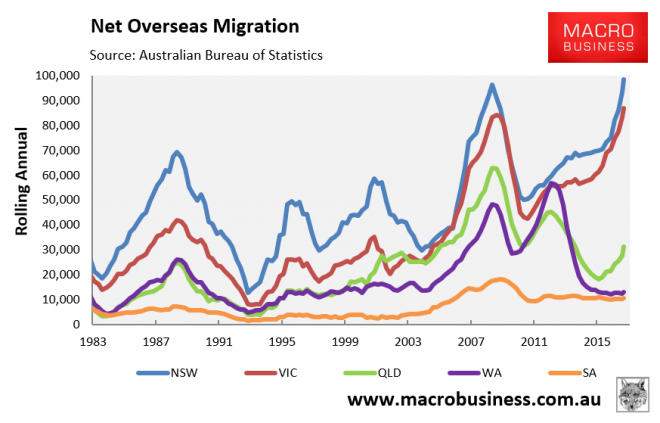
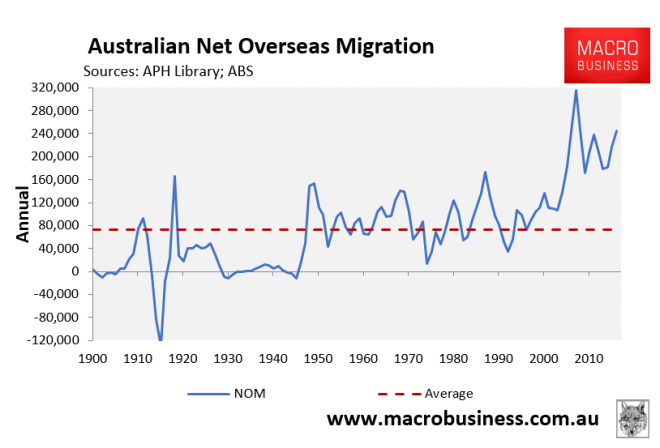
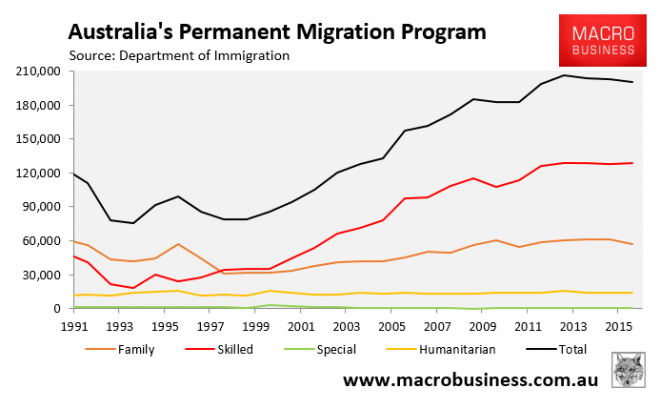

 Chief of Staff to former Prime Minister Tony Abbott, Peta Credlin, is the latest to question Australia’s mass immigration program, which flooded NSW (read Sydney) and VIC (read Melbourne) with a record 185,500 net overseas migrants (combined) in the year to June, further crush-loading our two biggest cities. This article was first published on Macrobusiness at
Chief of Staff to former Prime Minister Tony Abbott, Peta Credlin, is the latest to question Australia’s mass immigration program, which flooded NSW (read Sydney) and VIC (read Melbourne) with a record 185,500 net overseas migrants (combined) in the year to June, further crush-loading our two biggest cities. This article was first published on Macrobusiness at  "All sensible stuff [...]. No reference to irrelevant issues like race or culture. Just a sensible focus on Australia’s extreme immigration levels and their various deleterious impacts on ordinary Australians’ living standards. Sadly, while the speech reads like something that should have come from the Left, it instead came from One Nation’s Pauline Hanson. And because of this, it was blocked without debate by the Senate." (Article by
"All sensible stuff [...]. No reference to irrelevant issues like race or culture. Just a sensible focus on Australia’s extreme immigration levels and their various deleterious impacts on ordinary Australians’ living standards. Sadly, while the speech reads like something that should have come from the Left, it instead came from One Nation’s Pauline Hanson. And because of this, it was blocked without debate by the Senate." (Article by 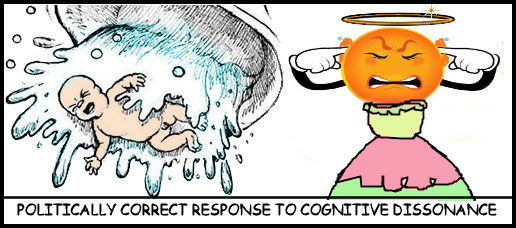
 With NSW’s (read Sydney’s) population growing at a break-neck pace (see below chart), last month it was revealed that there was a revolt underway from within the NSW Liberal Party against the federal government’s mass immigration program and over-development across Sydney (watch video).
With NSW’s (read Sydney’s) population growing at a break-neck pace (see below chart), last month it was revealed that there was a revolt underway from within the NSW Liberal Party against the federal government’s mass immigration program and over-development across Sydney (watch video).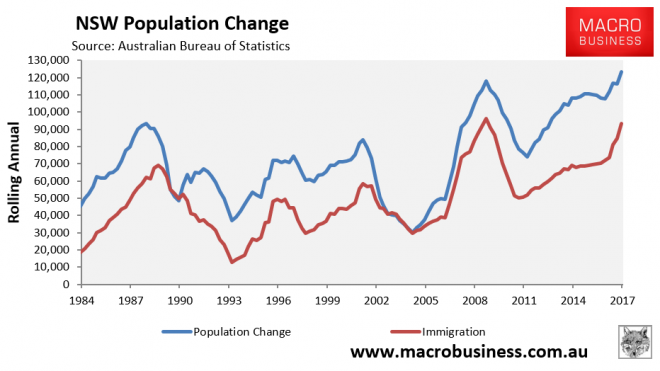
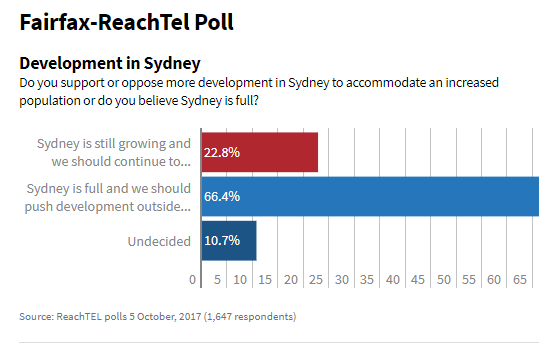
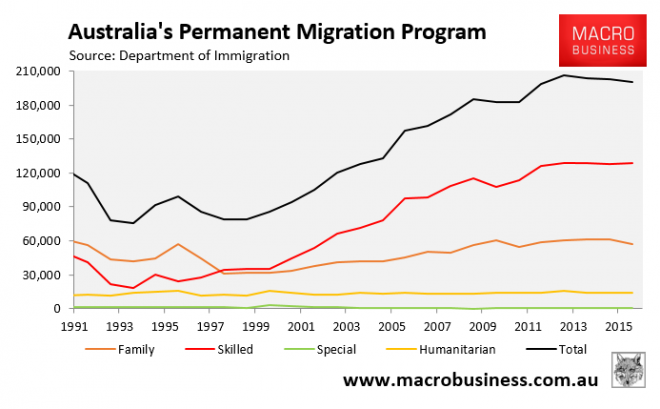
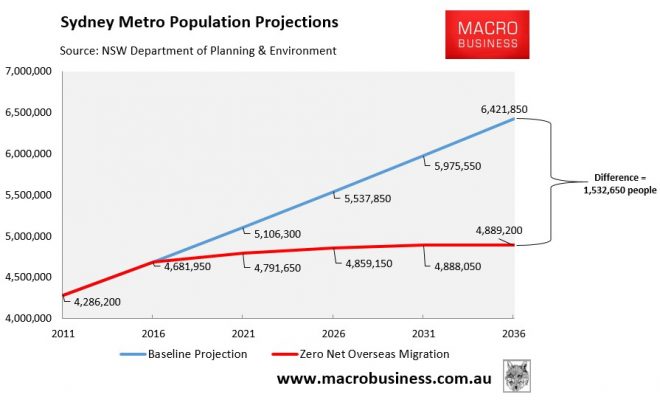
Recent comments